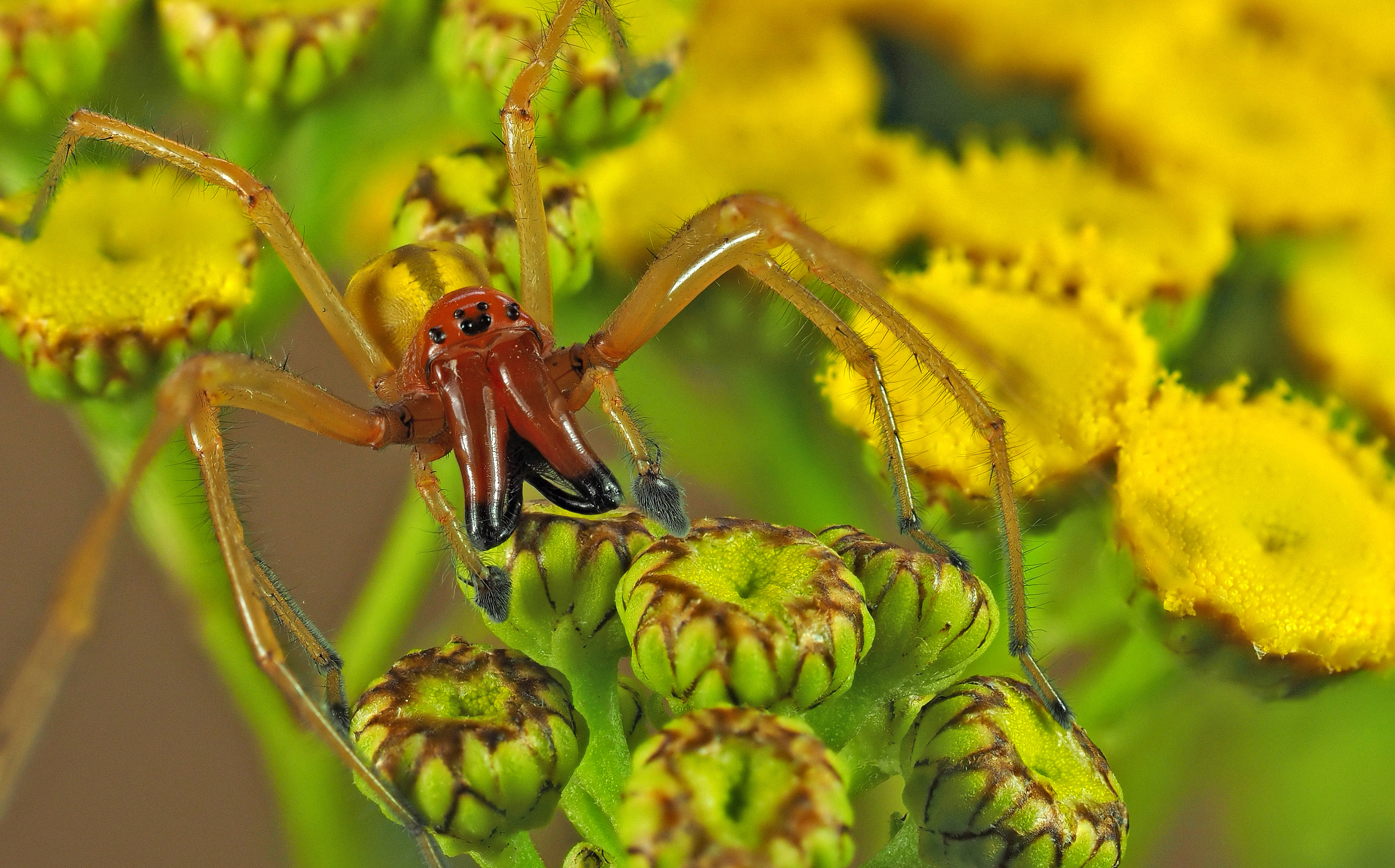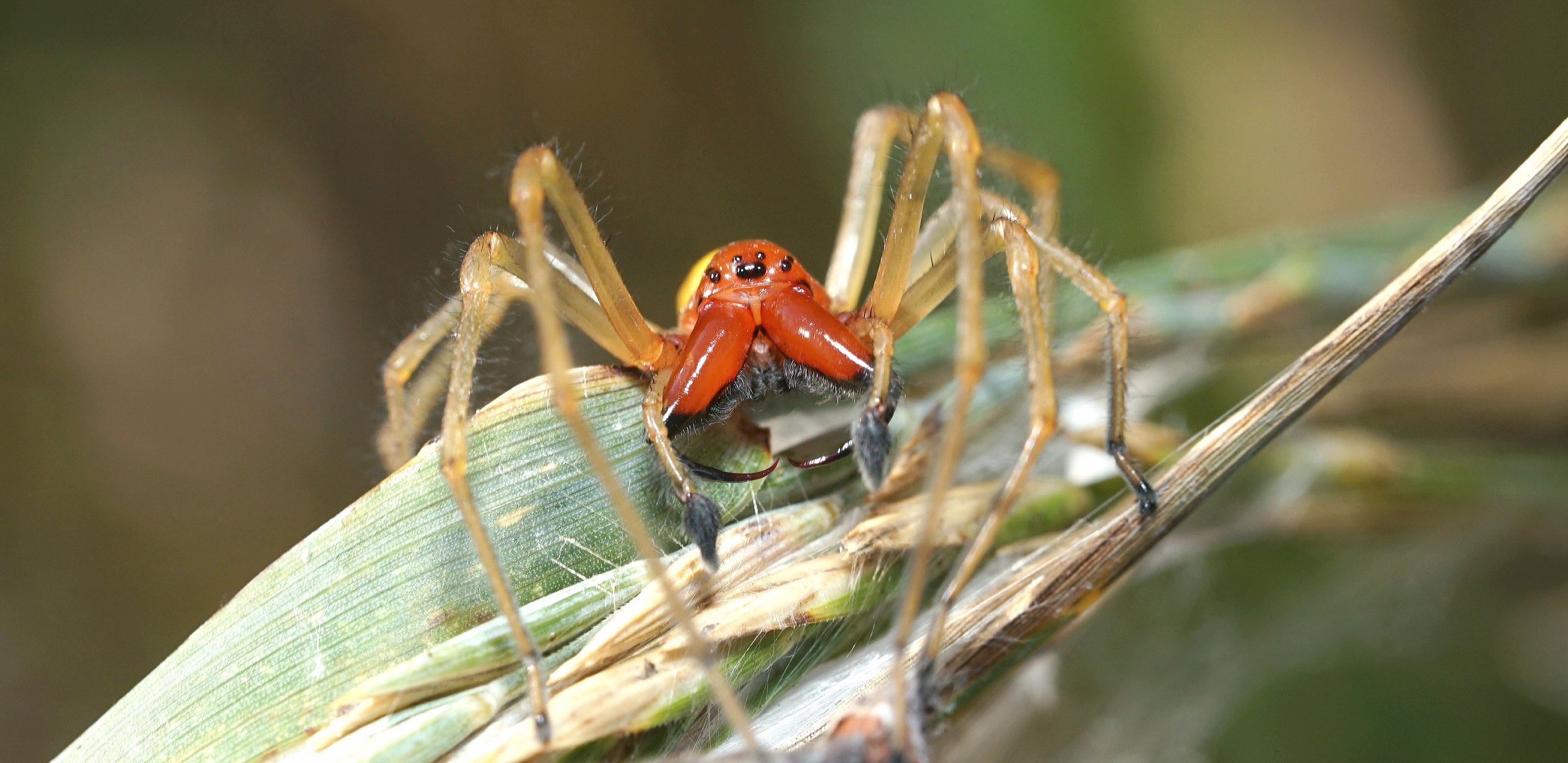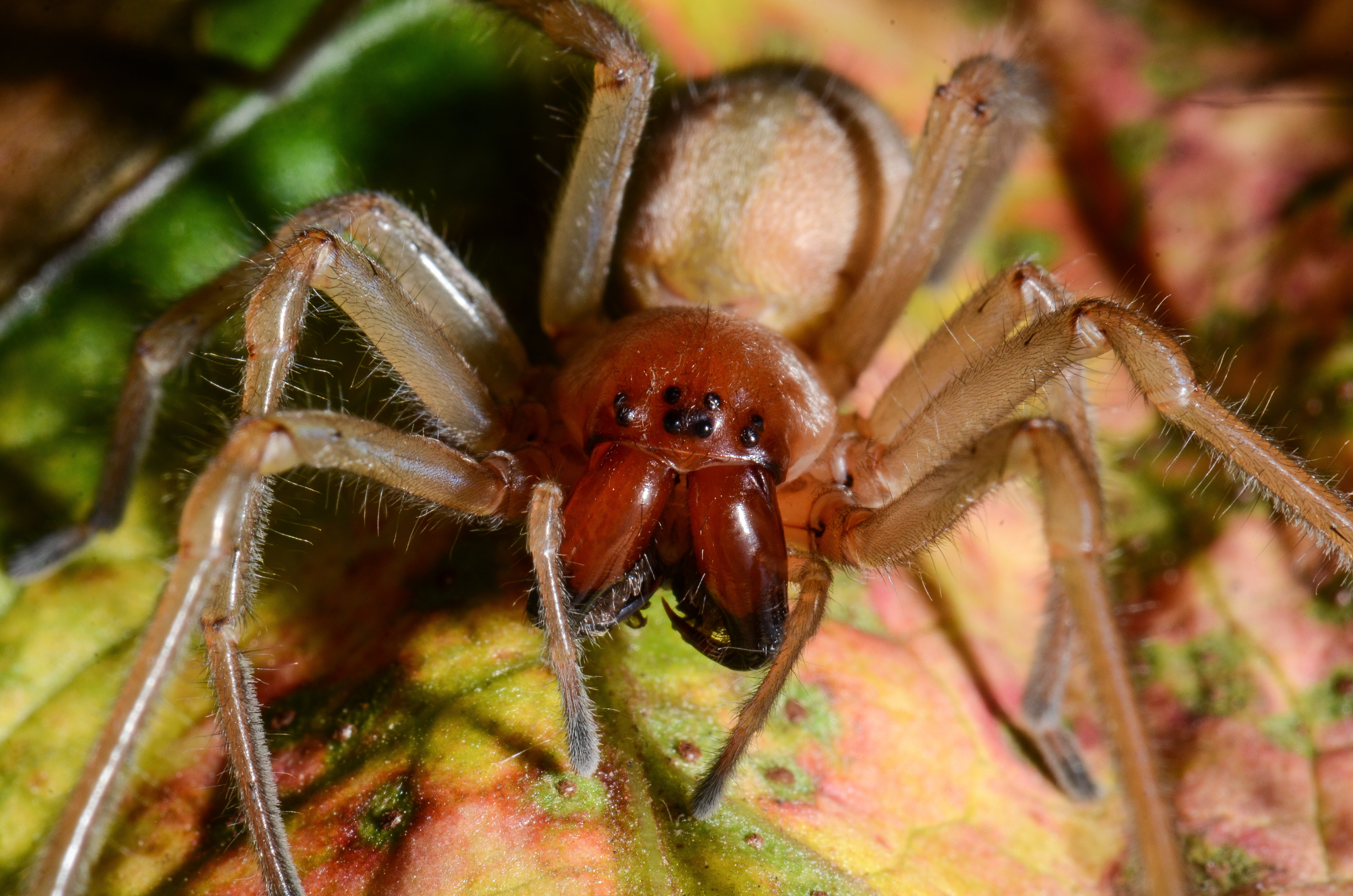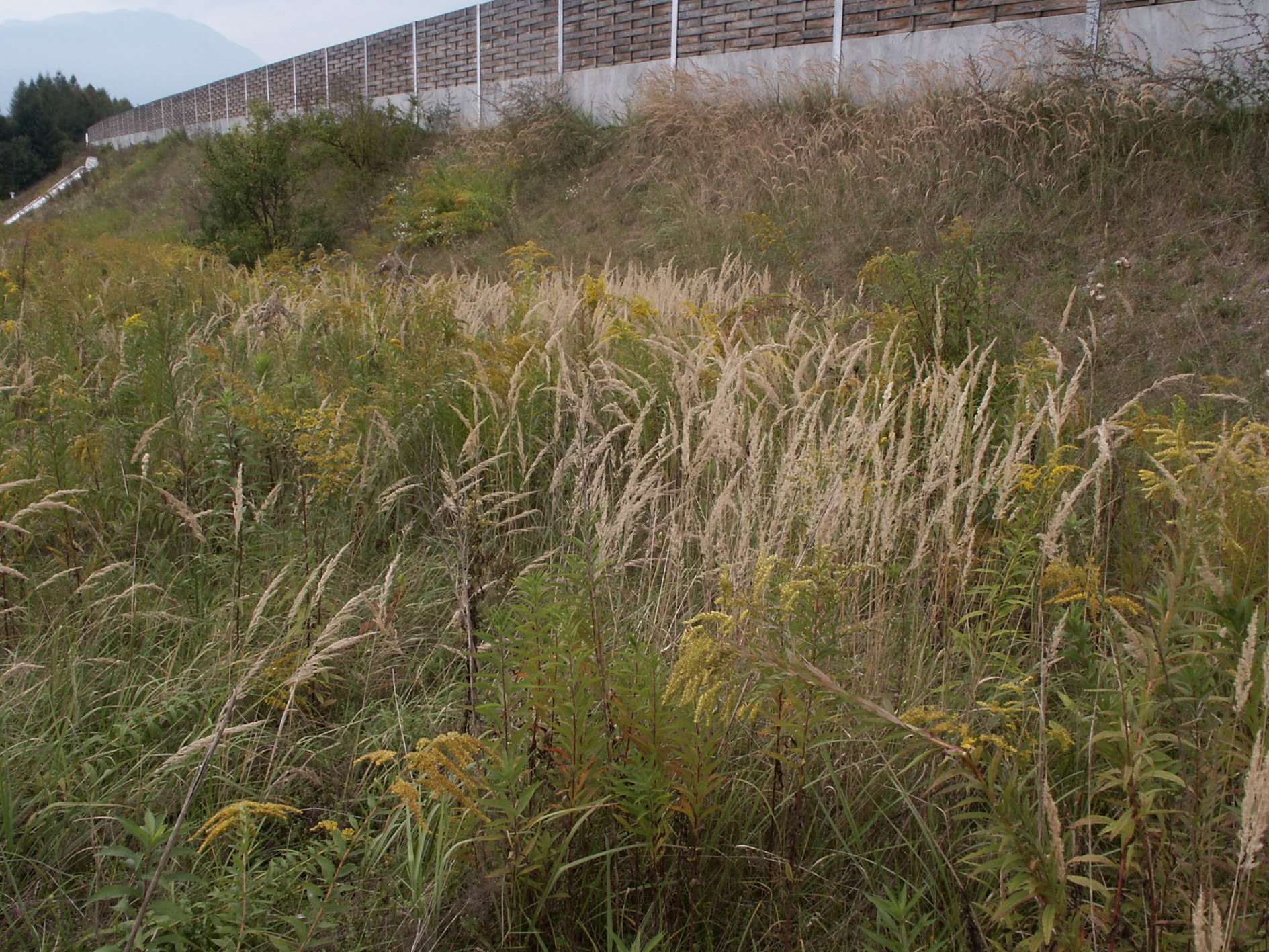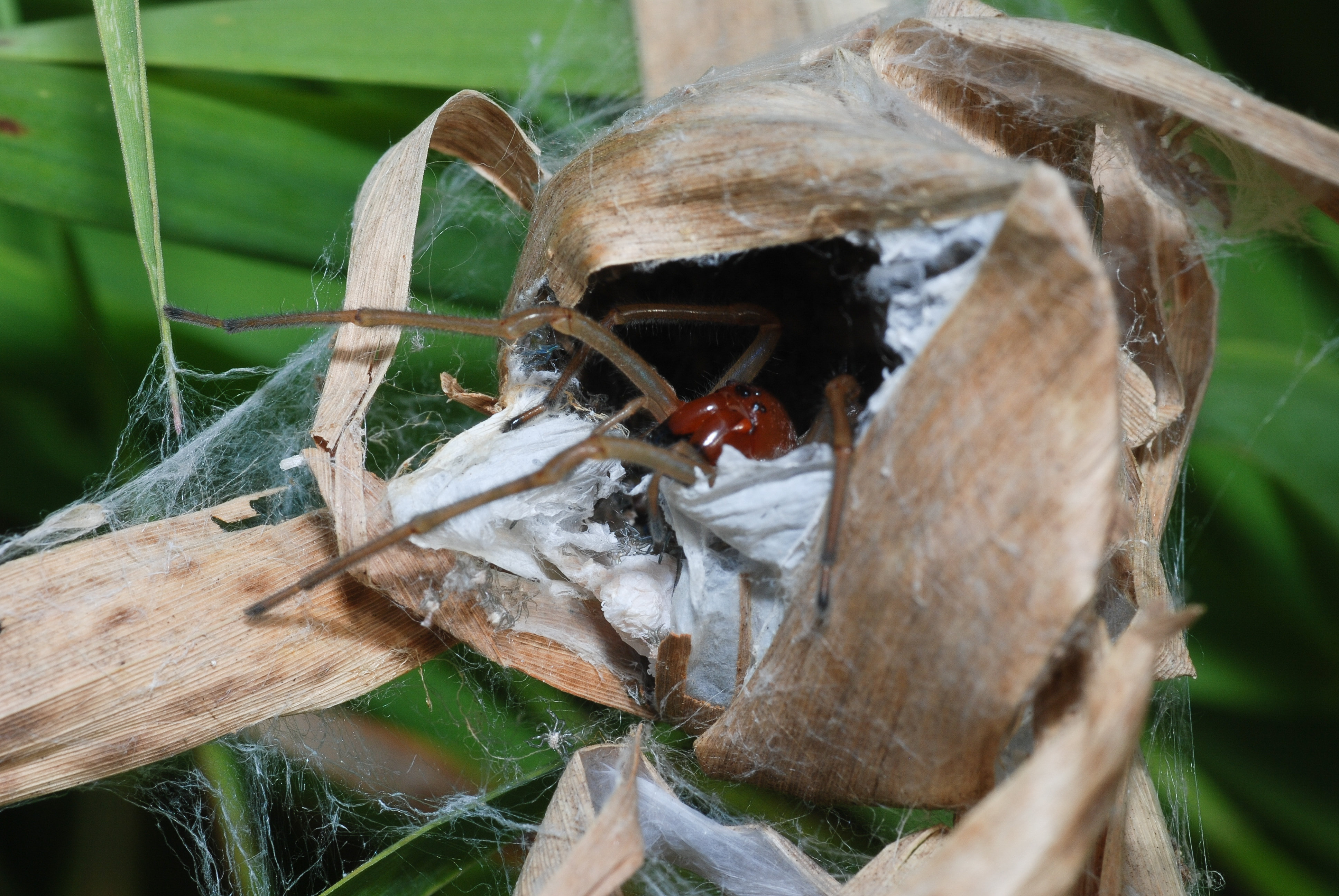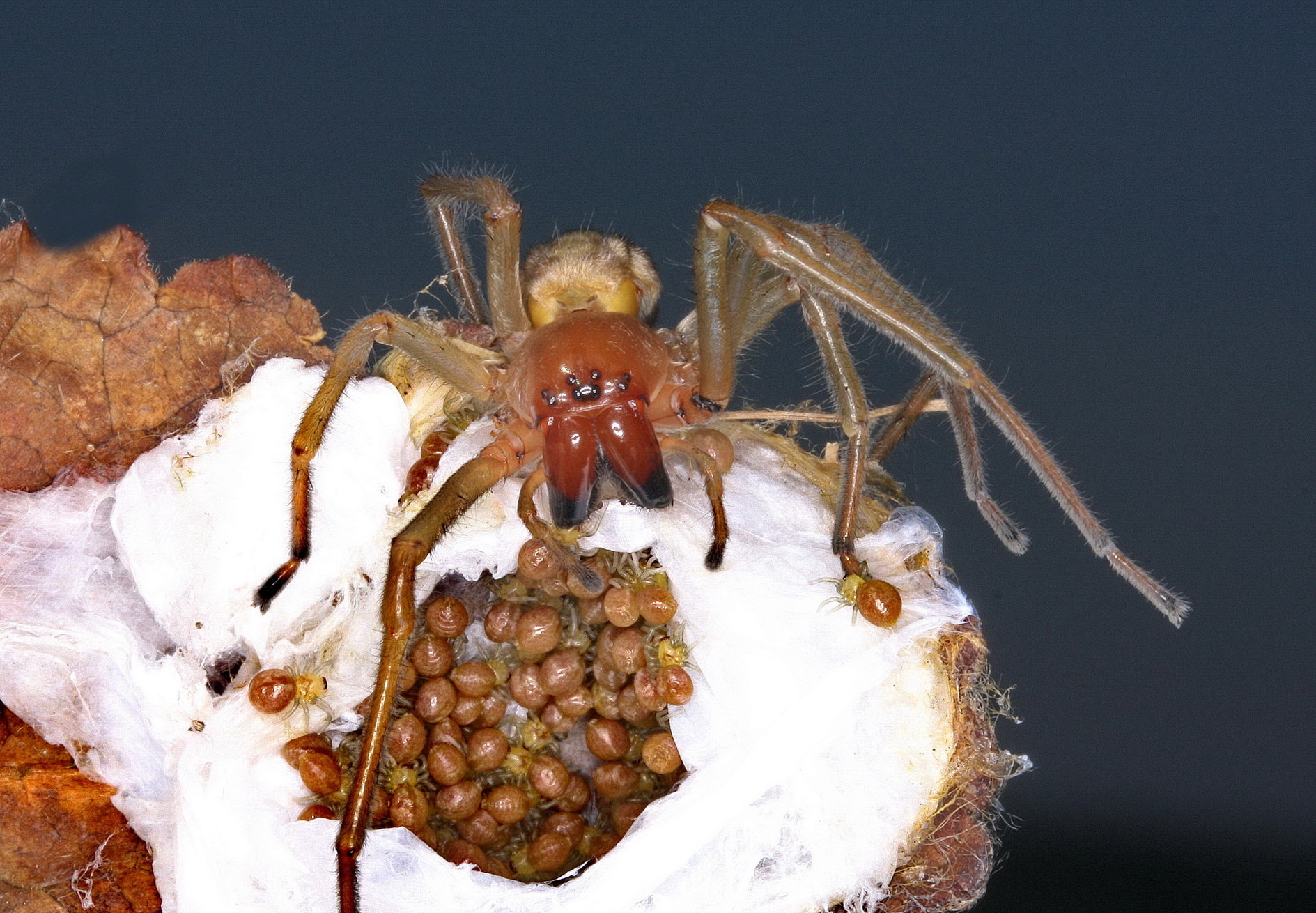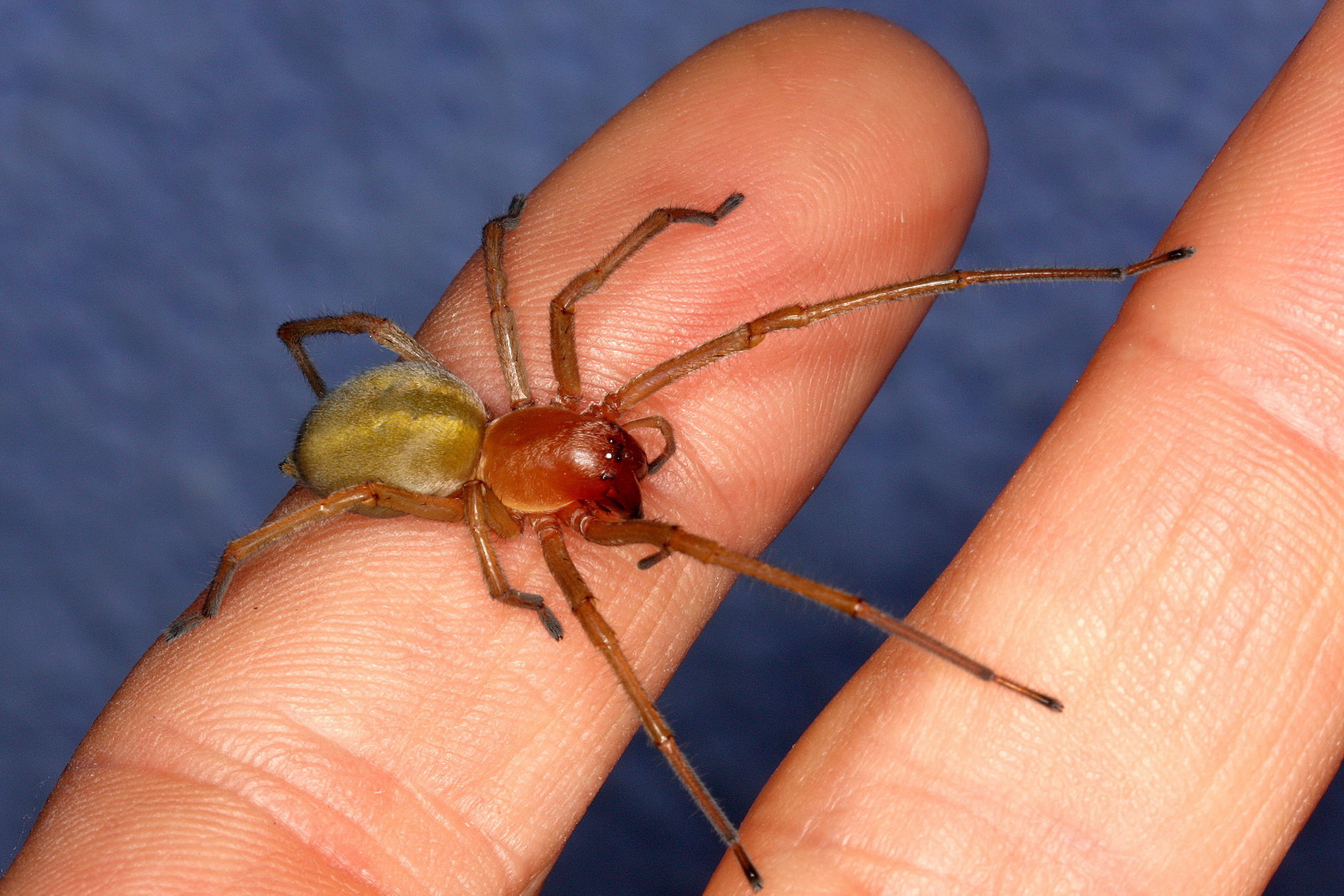Spider of the Year 2023
The Nurse’s thorn finger Cheiracanthium punctorium (Villers, 1789)
The Nurse’s thorn finger, Cheiracanthium punctorium (Villers, 1789), belongs to the family Cheiracanthiidae. This spider family has 363 species worldwide, of which 35 are known from Europe. In the genus Cheiracanthium (yellow sac spiders) there are 10 species in Austria, 12 in Germany and 7 in Switzerland.
Cheiracanthium punctorium is distributed across the Palearctic from Europe to Central Asia. In Central Europe the species occurs predominantly in planes and foothills at altitudes up to 800 m above sea level. There are, however, records at higher altitudes up to 1000 m. The species lives mostly in the herb and shrub layers of warm, open habitats, but also in wet areas of rarely used meadows. In Austria the species is not considered endangered, in several German states it was placed on the Red List, but its situation seems to improve.
Krehenwinkel et al. (2016) reported that over the last decade, a marked expansion of the species has been observed from the focal areas in the Mediterranean and south-western Germany up to northeastern Germany, southern Sweden, and the Baltic States, although with large gaps inbetween. The species shows a high genetic and ecological differentiation of the isolated populations and is highly adaptive to new (climatic) conditions. A spread of C. punctorium could be of relevance to humans, as it is one of very few Central European spider species whose venom can cause noteworthy effects on humans and may require medical treatment (Muster et al. 2008).
Text: Christoph Hörweg & Hubert Höfer
Description
The body length of female Cheiracanthium punctorium is around 10-15 mm, males are a little smaller at 7.5-2 mm. The cephalothorax is greenish-brown und can sometimes also be completely orange to red. The very robust and long mouthparts have a red basal part and the fang presents itself as a sharp, black, needle-like structure. The pale yellow–green abdomen often has a dark cardiac mark which can reach to the middle of the abdomen, but can also be completely absent.
The yellowish legs bear dark tips. The first pair of legs is elongate, which can be used to differentiate the genus Cheiracanthium from, e.g., sac spiders of the genus Clubiona.
Lifestyle
These mostly nocturnal spiders do not build a web to catch their food. They creep towards their prey and then overpower them with a venomous bite. Thanks to its large and powerful jaws the Nurse’s thorn finger can catch large insects like grasshoppers or praying mantises. The spiders spend the day in rounded silken retreats, usually in low vegetation, scrubby bushes or under stones. You can find them mainly in unused open biotopes, especially in tall grass and forb. The spiders also occur in forest openings, fallow land and meadows, as well as on the edges of paths and dykes, and on railway embankments.
In midsummer, subadult females build very noticeable, chicken-egg sized brood chambers which are intermeshed with blades of grass, leaves or stems. Directly next to the brood chamber, mature males spin their silken retreats. As soon as the female has moulted to maturity the male breaks through the wall between the two chambers and mating takes place. Afterwards in August, ca. 80-300 eggs are lain in a cocoon. During this time the female’s retreats are aggressively defended – like a nurse protecting her children. The common German name “Ammendornfinger” is a combination of a nurse (“Amme”) and thorn finger “Dornfinger”, which refers to a long, thin thorn on the male’s pedipalp.
The juvenile spiders hatch 3-5 weeks later in mid-September to early October, leave the brood chamber and overwinter is silken chambers which they build themselves close to the ground. These have a diameter of about 5 mm.
Venom
This species can bite people, especially if they try to catch or squeeze the animal. However, the reclusive lifestyle of the Nurse’s thorn finger, usually far away from human habitation, makes a bite relatively unlikely.
The bite causes an immediate intense burning pain that peaks after 5–20 minutes and can last for several hours. Pain intensity is reported as being like a wasp sting. The bite can cause symptoms such as moderate local swelling, redness, itching, nausea and a slight fever. Necrotic skin changes are not caused. If necessary, supportive care is recommended.
Similar species
The Nurse’s thorn finger can be easily distinguished from related species in Central Europe due to its prominent coloration and its striking size. Confusion can only arise with similar species from the sac spider family (Clubionidae).
Text: Christoph Hörweg
On the one hand, there has never been a representative of this spider family chosen. On the other hand, this species is mentioned quite often in the media because it is also associated with cases of bites and is therefore considered to be medically significant. Quite often these are, however, merely assumptions, thus it is all the more important to document corresponding cases and to demonstrate general information about this spider in order to avoid unfounded fears.
With the election of the spider of the year not only should a "less popular" group of animals be brought to the fore but also threatened habitats – in this case open, dry locations such as meadows, pastures and steppe grass – be indicated, but at the same time the scientists hope to obtain data about its current distribution. With this in mind: Enjoy the spider of the year and help with the documentation of this species with your locality report or your photo.
The "European Spider of the Year" was chosen by 84 arachnologists from 27 European countries. Coordination lies with the Natural History Museum Vienna, in cooperation with the Arachnological Society (AraGes) and the European Society of Arachnology (ESA).
Text: Christoph Hörweg
Countries involved
Albania, Austria, Belgium, Bulgaria, Croatia, Czech Republic, Denmark, Finland, France, Germany, Great Britain, Hungary, Ireland, Italy, Liechtenstein, Macedonia, The Netherlands, Norway, Poland, Portugal, Serbia, Slovakia, Slovenia, Spain, Sweden, Switzerland.
Supporting societies
- ARABEL - Belgische Arachnologische Vereniging
- ARAGES - Arachnologische Gesellschaft
- BAS - The British Arachnological Society
- CAS - Česká arachnologická společnost
- ESA - European Society of Arachnology
- GIA - Grupo Ibérico de Aracnología
- NATURDATA - Biodiversidade online (Portugal)
Contact for Europe
Dr. Milan Řezáč
Biodiversity Lab, Crop Research Institute
Drnovská 507
161 06 Praha 6 – Ruzyně
Czech Republic
reza(a)cvurv.cz
Distribution
- Europe at araneae Spiders of Europe
- in Austria
- in Benelux-countries
- in Czech Republic
- in Germany
- in Italy
- in Switzerland
Wikis and photo galeries
- Wiki of the Spinnen-Forum
- Wikimedia commons
- Pierre Ogers Galery Arachno (Les araignées de Belgique e de France )
- Fotogalerie der ehemaligen Nachweiskarten (spiderling.de)
- Arachnologische Gesellschaft e.V. 2022 Atlas der Spinnentiere Europas (Arachnida: Araneae, Opiliones, Pseudoscorpiones, Amblypygi, Solifugae, Scorpiones, Schizomida) für Cheiracanthium punctorium – (link) (06.12.2022)
- Arachnologische Gesellschaft e.V. 2022 Wiki des Spinnen-Forums – (link) (06.12.2022)
- Bellmann H 2016 Der Kosmos Spinnenführer. Frackh-Kosmos Stuttgart. 429 pp.
- Blick T, Bosmans R, Buchar J, Gajdoš P, Hänggi A, Helsdingen P van, Růžička V, Staręga W & Thaler K 2004 Checkliste der Spinnen Mitteleuropas. Checklist of the spiders of Central Europe. (Arachnida: Araneae). Version 1. Dezember 2004
- Breitling R, Merches E, Muster C, Duske K, Grabolle A, Hohner M, Komposch C, Lemke M, Schäfer M & Blick T 2020 Liste der Populärnamen der Spinnen Deutschlands (Araneae) – Arachnologische Mitteilungen 59:38-60. doi: 10.30963/aramit5907
- CSCF (Centre Suisse de Cartographie de la Faune) 2019 Fauna der Schweiz – Spinnentiere oder Arachniden (Skorpione, Pseudoskorpione, Spinnen, Weberknechte, Milben) – (link) bzw. Verbreitungskarte für Cheiracanthium punctorium: (link) (06.12.2022)
- Foelix RF 2015 Biologie der Spinnen. Edition Chimaira, Frankfurt am Main. 430 pp.
- Hänggi A, Stöckli E & Nentwig W 1995 Lebensräume mitteleuropäischer Spinnen. Charakterisierung der Lebensräume der häufigsten Spinnenarten Mitteleuropas und der mit diesen vergesellschafteten Arten – Miscellanea Faunistica Helvetiae 4: 1-459
- Helsdingen PJ van 2021 Araneae. In: Fauna Europaea version 2017.06 – (link) (06.12.2022)
- Krehenwinkel, H et al. 2016 Rapid genetic and ecological differentiation during the northern range expansion of the venomous yellow sac spider Cheiracanthium punctorium in Europe. – Evolutionary Applications 9: 1229-1240.
- Muster C 2021 Artensteckbrief Ammendornfinger in Rote-Liste-Zentrum. (link) (06.12.2022)
- Nentwig W, Blick T, Bosmans R, Gloor D, Hänggi A & Kropf C 2021 araneae – Spiders of Europe, version 12.2022 – (link) (06.12.2022). doi: 10.24436/1
- Reichholf JH & Steinbach G 1997 Die grosse Enzyklopädie der Insekten, Spinnen- und Krebstiere, Band 1. Bertelsmann Lexikon Verlag Gütersloh. 360 pp.
- World Spider Catalog 2022 World Spider Catalog, version 23.5. Natural History Museum Bern – (link) (06.12.2022)



